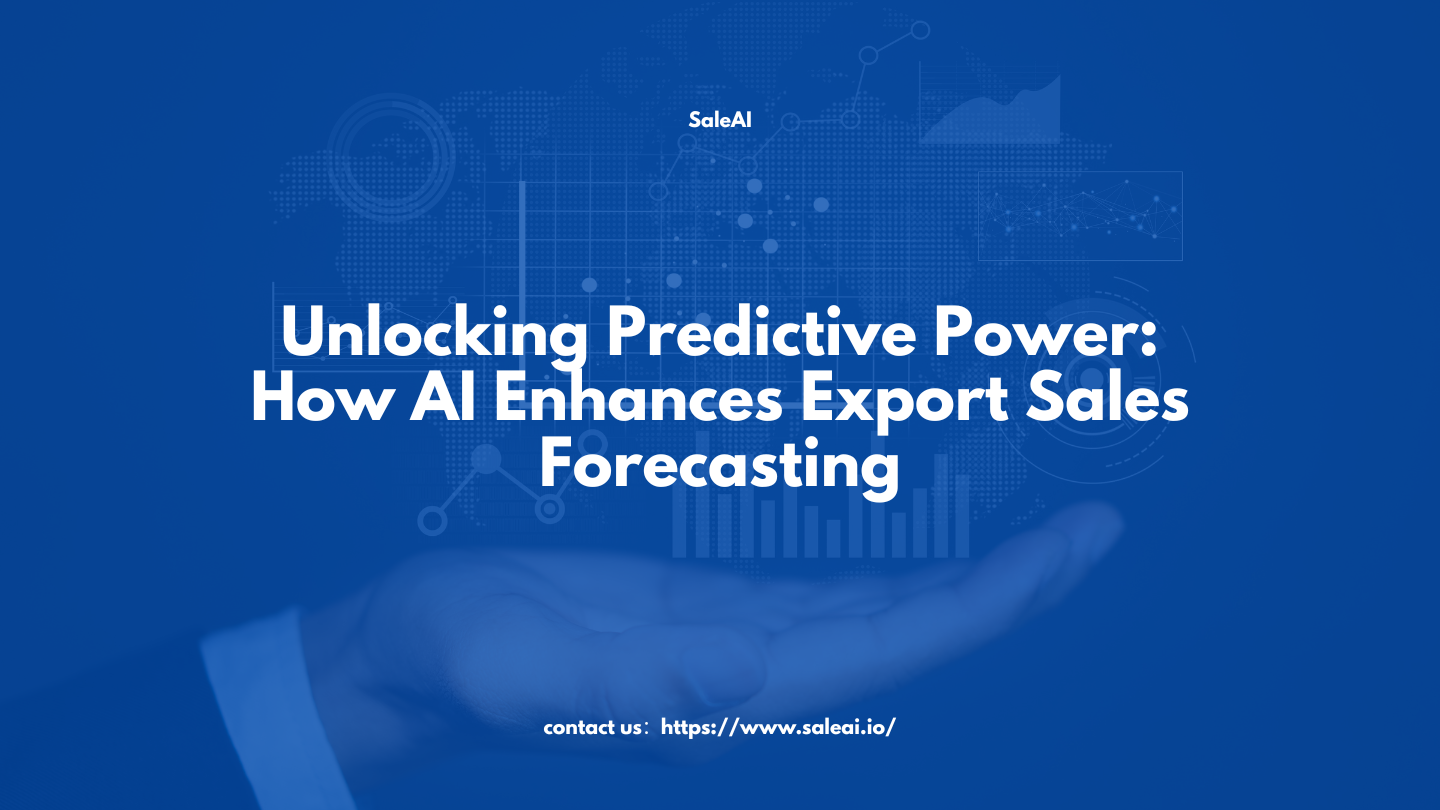Introduction: The New Era of Export Sales Forecasting
Export sales forecasting has long been a cornerstone for planning and decision-making in global trade. Whether it’s ensuring adequate inventory, aligning production schedules, or planning for market expansion, accurate forecasting is critical. But in an increasingly volatile global market, traditional methods often fall short.
AI is not just an enhancement to forecasting—it’s a paradigm shift. By integrating real-time data, machine learning, and predictive analytics, AI empowers exporters to:
- Predict demand with unparalleled precision.
- Respond dynamically to market changes.
- Optimize resource allocation for maximum efficiency.
Let’s explore how AI is transforming export sales forecasting and why it’s becoming an indispensable tool for exporters.
Part I: Why Traditional Forecasting Falls Behind
a. The Data Disconnect
Traditional forecasting relies heavily on historical sales data, often ignoring external factors such as:
- Currency fluctuations.
- Geopolitical shifts.
- Evolving consumer preferences.
Without these inputs, forecasts can become disconnected from current market realities.
b. Fixed and Rigid Models
Static forecasting models fail to adapt to sudden changes, such as:
- Unexpected supply chain disruptions.
- Seasonal demand variations.
- Competitor price adjustments.
c. Time-Consuming Processes
Manual forecasting often involves spreadsheets, guesswork, and repetitive updates, leading to inefficiencies and errors.
💡 Key Insight: Traditional methods, while foundational, lack the flexibility and adaptability required for modern global trade.
Part II: How AI Elevates Export Sales Forecasting
a. Dynamic Data Integration
AI integrates data from diverse sources, including:
- Internal Data: Historical sales, inventory levels, and production capacity.
- External Data: Trade patterns, economic indicators, and competitor activity.
This holistic approach ensures forecasts are grounded in both internal realities and external market conditions.
💡 Example: A machinery exporter combined real-time trade data and historical sales records to predict seasonal demand spikes in Southeast Asia, leading to a 20% reduction in stockouts.
b. Real-Time Forecast Adjustments
Markets evolve rapidly, and AI ensures your forecasts evolve with them by:
- Continuously analyzing data streams.
- Flagging deviations from predicted trends.
- Automatically updating forecasts to reflect new information.
💡 Case Study: A furniture exporter adapted to sudden raw material price increases by recalibrating forecasts with SaleAI’s real-time analytics, avoiding overproduction.
c. Forecasting Across Multiple Scenarios
AI enables exporters to simulate various "what-if" scenarios, such as:
- How will demand shift if tariffs increase?
- What’s the impact of launching a new product line?
- How would currency fluctuations affect profitability?
These simulations provide actionable insights, helping businesses prepare for multiple outcomes.
💡 Pro Tip: Use scenario planning to develop contingency strategies for high-risk markets.
d. Regional and Segment-Specific Forecasting
AI provides granular insights, allowing exporters to:
- Tailor forecasts to specific regions or countries.
- Analyze demand trends for individual product lines.
- Segment buyers based on purchasing behavior.
💡 Example Insight: A food exporter used AI to identify rising demand for plant-based products in North America, refining their product portfolio to capitalize on the trend.
e. Risk Identification and Mitigation
AI doesn’t just predict opportunities—it also flags risks, such as:
- Declines in buyer activity.
- Competitive pressures in key markets.
- Macroeconomic instability.
This allows exporters to proactively address challenges before they escalate.
💡 Case Study: A home appliance exporter avoided significant losses by identifying a declining trend in a saturated market and redirecting efforts to untapped regions.
Part III: Practical Applications and Benefits
Tangible ROI of AI in Sales Forecasting
| Metric | Before AI | With AI |
|---|---|---|
| Forecast Accuracy | 70%-75% | 90%-95% |
| Time to Update Forecasts | Weeks | Real-Time |
| Cost Savings | Moderate | 20%-30% Reduction |
| Risk Response Time | Reactive | Proactive |
💡 Key Takeaway: AI-powered forecasting not only improves accuracy but also enhances agility and cost efficiency, delivering a strong competitive advantage.
Part IV: Actionable Steps to Implement AI in Forecasting
a. Start with Data Consolidation
Integrate all available data sources, including sales records, market trends, and competitor analysis. AI thrives on data diversity.
b. Choose the Right Tools
Adopt AI platforms like SaleAI that specialize in export forecasting, offering features such as predictive analytics, scenario planning, and real-time updates.
c. Train Your Teams
Ensure your team understands how to interpret AI-generated forecasts and integrate them into decision-making processes.
d. Monitor and Optimize
Continuously evaluate the performance of AI tools, making adjustments to improve accuracy and relevance.
Why Choose SaleAI for Export Sales Forecasting?
-
Predictive Analytics:
- Combines historical and real-time data for accurate, actionable forecasts.
- Identifies emerging trends and demand shifts.
-
TradeLink AI Insights:
- Analyzes global trade data to uncover market opportunities and risks.
- Provides regional and product-specific forecasting.
-
Scenario Simulation Tools:
- Allows exporters to test various market conditions and prepare for uncertainties.
- Supports data-driven decision-making.
-
Risk and Opportunity Alerts:
- Proactively flags risks such as declining demand or supply chain disruptions.
- Highlights growth opportunities in untapped markets.
The Future of AI in Sales Forecasting
As AI technology evolves, its role in sales forecasting will expand further to include:
- Sentiment Analysis: Using buyer feedback and market sentiment to refine forecasts.
- AI-Driven Negotiation Support: Predicting the best terms for contracts based on market data.
- Blockchain Data Integration: Leveraging transparent supply chain data for even greater forecast accuracy.
Exporters who invest in AI today will not only gain immediate benefits but also position themselves for long-term success in an increasingly complex global market.
Conclusion: The Strategic Edge of AI in Export Forecasting
Sales forecasting is no longer just about projecting numbers—it’s about enabling smarter, faster, and more informed business decisions. With AI-powered tools like SaleAI, exporters can:
- Achieve higher accuracy in demand planning.
- Adapt dynamically to market changes.
- Proactively mitigate risks and seize opportunities.





